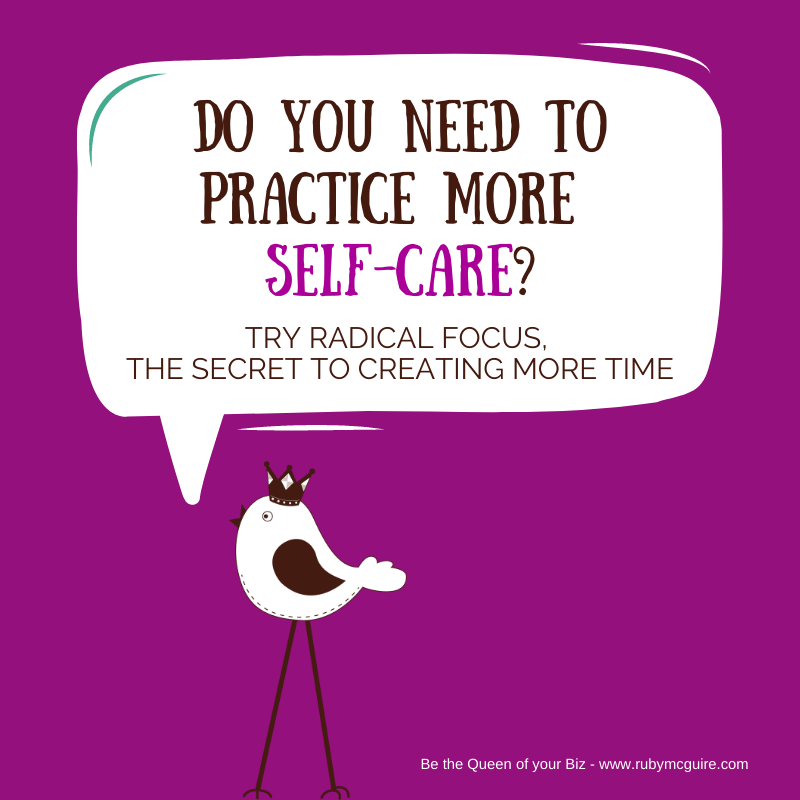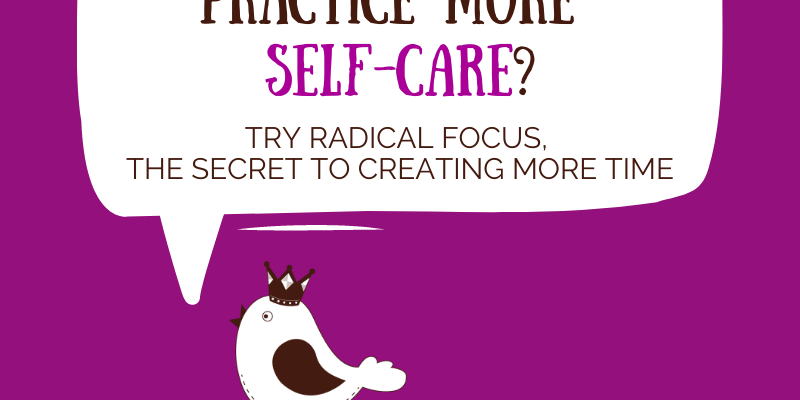Originally Posted on The Coaching Tools Company as Be Kind to Yourself and Get More Done with Radical Focus! | By Ruby McGuire
 Whether you’re just starting out, or you’ve been in business a few years, it’s always great testing out new ways to take your business to the next level.
Whether you’re just starting out, or you’ve been in business a few years, it’s always great testing out new ways to take your business to the next level.
About a year ago, I was working in a writing app called Scrivener, which has a “distraction free” setting. Little did I know that it would become a pivotal point in my business.
Out of this incredibly helpful setting came a term I like to use: Radical Focus. Radical Focus is a beautiful self-care gift you can give yourself. It’s simple, but not easy. All it takes is a bit of thought—and a LOT of discipline. And as I shared in an article I wrote for Thrive Magazine last year, radical or “extreme focus” is simply about focusing on One. Single. Thing. Nothing else matters apart from the task at hand.
The price of distraction
When you focus 100% on the task at hand, you get so much more work done. I know. It’s not exactly rocket science, is it?! It’s obvious! But how often do you do it?
When interrupted while working, it can take 23 minutes to get back to the flow state you were in when you stopped. Of course there are caveats; for example, if the interruption is related to what you’re working on, the recovery time can be quicker.
But suppose you’re distracted by Facebook notifications, email, LinkedIn messages, etc. You may make it back quickly to the task you were working on—but probably not with the same depth of focus you had before the interruption.
When I observed how I worked, I realised I would think I was hyper-focused on my task list, but the reality was very different: I was checking emails in between, answering messages, thinking about tasks unrelated to what I was working on, and being in the past or the future, not focused on the one thing that I needed to do.
How I’ve learned to stay focused
I’ve probably used “all of the things” you can think of to stay focused, with varying results. This list includes closing down tabs on my desktop, carving out time blocks and using the Pomodoro Technique1, to name just a few.
But Radical Focus is different. Just the name can give your work a sense of urgency and importance. And this type of focus creates calm and clarity. It blows my mind how much you can get done when you practise this method.
At one point I was so excited about this concept I thought I’d write a book on it! That’s how much it has changed the way I work. But when I checked online to see what was out there, someone has already written a book on it. Side note: No ideas are new ideas. So that doesn’t mean you can’t share your version of them…
Alongside practising Radical Focus, reducing social media in my business has made an enormous difference2.
Simple, but not easy
Radical Focus is a very simple concept but not necessarily easy to implement.
It takes time to build up the habit. And in this information era, we are overloaded with so many stimuli that it can sometimes be challenging to know what we need to work on and prioritize.
So here’s how you do it, and a few tips to make it easier.
6 Steps to Create your Radical Focus (RF) session
- Get clarity on the ONE thing you’re going to focus on in your RF session. Be specific about the outcome you want to achieve.
- Create a time block. Decide on the length of time for your session and block out that time.
- Eliminate every single distraction. Block everything out. No apps, no notifications, just the one task you’re working on. I use Scrivener—there are no tabs to distract me, no icons for formatting or editing, etc. It’s just me with one piece of online paper.
- Set yourself up for success. Create the right environment—place, space, light, music, candles, whatever you need to help you stay in the focused zone.
- Focus on the ONE thing for the duration of your session.
- Keep a distraction log. Have a notebook beside you while you work. When something pops into your head that isn’t related to the task, write it down. You can deal with it later.
Then review your session
Once you get to the end of your session, review the process:
- What worked?
- What didn’t work?
- And what could you stop-start-continue3 to make your next session better?
- Check your distraction log. What were the main things distracting you/calling for your attention?
Lastly, reward yourself
Set something lovely in place for the end of your session. If you’ve stuck to being distraction-free, you will more than likely have done some intense work. Here are a few ideas:
- Read for five minutes.
- Sit in the garden.
- Call a friend.
- Do some yoga.
- Spend some time colouring or doodling.
So, how is Radical Focus related to self-care?
When you practise Radical Focus, you get so much more work done in the time available to you. And the more you do it, the more time you “create” in your day.
I’ve worked with clients with only tiny pockets of time to work on their business. By practising Radical Focus, they’ve written books, attracted clients, created passive income stream programs and much more.
And with Radical Focus, you can create a far better work-life balance. Now when I work, I’m incredibly focused on the right things. As a result, I get to do more of the things I love, like writing my books, creating handmade cards and enjoying living my life up here in Scotland. (Oh yes, and drinking copious amounts of cappuccino!)
Radical Focus takes guts—because it means pushing against your FOMO (fear of missing out).
Wrap-up
If you want to create a better work-life balance, practise Radical Focus.
You’ll get way more work done, the quality of the work will be better, you’ll feel more productive and you’ll free up space to do all those other lovely things you enjoy doing outside of your business.
Resources1 Learn more about The Pomodoro Technique here: https://francescocirillo.com/pages/pomodoro-technique 2 For more on this read Sick of Social Media? How to Grow Your Business Without It! also by Ruby McGuire 3 You may like our Action Brainstorming Worksheet that has a column for what you could Stop/Start/Continue Doing/Do More/Less of. |
What do you think? Could this idea help you? Share your thoughts in the comments below.
You May Also Like these other articles on Focusing:







